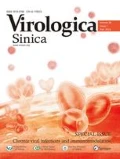Abstract
Protein phosphorylation is one of the most common post-translational modification processes that play an essential role in regulating protein functionality. The Helicoverpa armigera single nucleopolyhedrovirus (HearNPV) orf2-encoded nucleocapsid protein HA2 participates in orchestration of virus-induced actin polymerization through its WCA domain, in which phosphorylation status are supposed to be critical in respect to actin polymerization. In the present study, two putative phosphorylation sites (232Thr and 250Ser) and a highly conserved Serine (245Ser) on the WCA domain of HA2 were mutated, and their phenotypes were characterized by reintroducing the mutated HA2 into the HearNPV genome. Viral infectivity assays demonstrated that only the recombinant HearNPV bearing HA2 mutation at 245Ser can produce infectious virions, both 232Thr and 250Ser mutations were lethal to the virus. However, actin polymerization assay demonstrated that all the three viruses bearing HA2 mutations were still capable of initiating actin polymerization in the host nucleus, which indicated the putative phosphorylation sites on HA2 may contribute to HearNPV replication through another unidentified pathway.
Similar content being viewed by others
Reference
Burton E A, Oliver T N, Pendergast A M. 2005. Abl kinases regulate actin comet tail elongation via an N-WASP-dependent pathway. Mol Cell Biol, 25: 8834–8843.
Goley E D, Ohkawa T, Mancuso J, et al. 2006. Dynamic nuclear actin assembly by Arp2/3 complex and a baculovirus WASP-like protein. Science, 314: 464–467.
Hess R T, Goldsmith P A, Volkman L E. 1989. Effect of cytochalasin D on cell morphology and AcMNPV replication in a Spodoptera frugiperda cell line. J Invertebr Pathol, 53: 169–182.
Keddie B A, Aponte G W, Volkman L E. 1989. The pathway of infection of Autographa californica nuclear polyhedrosis virus in an insect host. Science, 243: 1728–1730.
Luckow V A, Lee S C, Barry G F, et al. 1993. Efficient generation of infectious recombinant baculoviruses by site-specific transposon-mediated insertion of foreign genes into a baculovirus genome propagated in Escherichia coli. J Virol, 67: 4566–4579.
May R C, Hall M E, Higgs H N, et al. 1999. The Arp2/3 complex is essential for the actin-based motility of Listeria monocytogenes. Curr Biol, 9: 759–762.
Miki H, Miura K, Takenawa T. 1996. N-WASP, a novel actin-depolymerizing protein, regulates the cortical cytoskeletal rearrangement in a PIP2-dependent manner downstream of tyrosine kinases. EMBO J, 15: 5326–5335.
Nie Y, Wang Q, Liang C, et al. 2006. Characterization of ORF2 and its encoded protein of the Helicoverpa armigera nucleopolyhedrovirus. Virus Res, 116: 129–135.
Vialard J E, Richardson C D. 1993. The 1,629- nucleotide open reading frame located downstream of the Autographa californica nuclear polyhedrosis virus polyhedrin gene encodes a nucleocapsid-associated phosphoprotein. J Virol, 67: 5859–5866.
Volkman L E. 1988. Autographa californica MNPV nucleocapsid assembly: inhibition by cytochalasin D. Virology, 163: 547–553.
Wang H, Deng F, Pijlman G P, et al. 2003. Cloning of biologically active genomes from a Helicoverpa armigera single-nucleocapsid nucleopolyhedrovirus isolate by using a bacterial artificial chromosome. Virus Res, 97: 57–63.
Wang Q, Liang C, Song J, et al. 2007. HA2 from the Helicoverpa armigera nucleopolyhedrovirus: a WASP-related protein that activates Arp2/3-induced actin filament formation. Virus Res, 127: 81–87.
Wang Q, Wang Y, Liang C, et al. 2008. Identification of a hydrophobic domain of HA2 essential to morphogenesis of Helicoverpa armigera nucleopoly- hedrovirus. J Virol, 82: 4072–4081.
Wang Y, Wang Q, Liang C, et al. 2008. Autographa californica multiple nucleopolyhedrovirus nucleocapsid protein BV/ODV-C42 mediates the nuclear entry of P78/83. J Virol, 82: 4554–4561.
Author information
Authors and Affiliations
Corresponding author
Additional information
Foundation items: National Nature Science Foundations of China (31030027, 30770085 and 30800044).
Rights and permissions
About this article
Cite this article
Lv, Yp., Wang, Q., Wu, Cc. et al. Putative phosphorylation sites on WCA domain of HA2 is essential for Helicoverpa armigera single nucleopolyhedrovirus replication. Virol. Sin. 26, 245–251 (2011). https://doi.org/10.1007/s12250-011-3189-6
Received:
Accepted:
Published:
Issue Date:
DOI: https://doi.org/10.1007/s12250-011-3189-6




